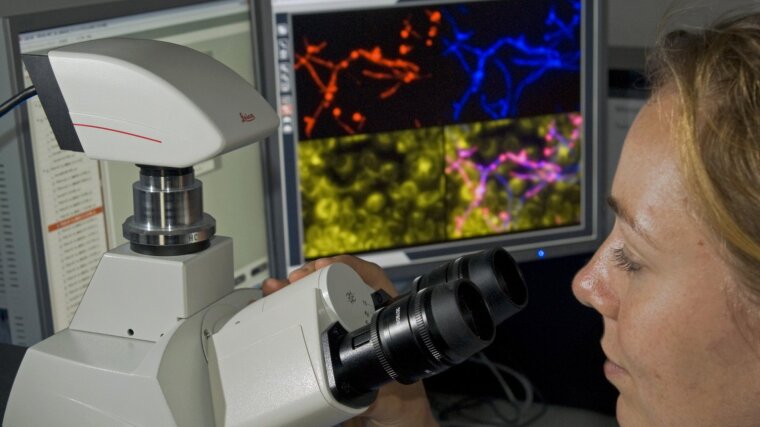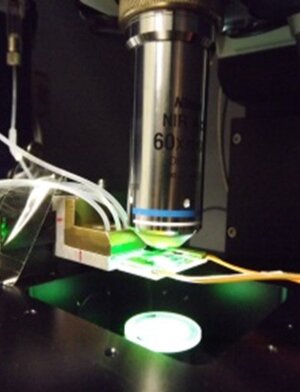
Prof. Ute Neugebauer
Image: PrivateProf. Dr. Ute NEUGEBAUER
Email: ute.neugebauer@uni-jena.de
Phone: +49 3641-9-390900/39
+49 3641-206-103
Ute Neugebauer is professor of Physical Chemistry and head of the research department Clinical Spectroscopic Diagnostics at the Leibniz Institute of Photonic Technology (Leibniz-IPHT). She is deputy scientific director of the Leibniz-IPHT, leader of the Core Unit Biophotonics of the Center for Sepsis Control and Care at Jena University Hospital and involved in the Executive Committee of the Core Facility Jena Biophotonic and Imaging Laboratory (JBIL).
Research Areas
The main research interest of the group of Prof. Neugebauer is the investigation, development and application of novel spectroscopic tools and methods for medical diagnostics and the characterization of physiological interactions in particular in the context of infections and sepsis. This includes the detailed characterization of the pathogen causing the infection, its localization within the host cells, the elucidation of its interaction with drugs and with the host, and the analysis of the host response to the infection, here with a special focus on immune cells.
Teaching Fields
Prof. Neugebauer gives lectures for students in chemistry and the interdisciplinary Master’s degree course Medical Photonics. Her courses include:
- Physical chemistry
- Light-matter interaction
- Applied physical chemistry
Her teaching is devoted to the early involvement of students and young scientists in state-of-the-art research.
Research Methods
In our research we use advanced biophotonic tools with a focus on Raman- and fluorescence-based methods. To allow optimal handling of biological samples and in order to shorten the time required for diagnosis, we integrate label-free and non-destructive photonic methods into bioanalytical chip systems.
Recent Research Results
Figure 1: Microfluidic system under the Raman microscope for the spectroscopic characterization of antibiotic susceptibility
Image: Sven Döring, Leibniz-IPHT.Photonic methods hold a high potential to improve medical infection diagnostics, in particular shorten the time-to-diagnosis [1]. The optical-spectroscopic method developed in the last years can spectroscopically characterize the interaction of antibiotics with bacteria. Characteristic changes in the bacterial spectrum and morphological changes indicate effective action of the antibiotic, but also help to identify antibiotic resistance. Using statistical data analysis algorithms antibiotic susceptibility of patient isolates can be determined within only a few hours [2]. In times of rising antibiotic resistances this is of utmost importance. The spectroscopic characterization takes only a few hours and the result can be qualitative, i.e. to differentiate between sensitive and resistant behavior, or quantitative [3], i.e. to determine the minimum inhibitory concentration (MIC: concentration of antibiotics that visibly inhibits bacterial growth). These research activities are continued in collaboration with Prof. Dr. Jürgen Popp and his group. Furthermore, the spectroscopic methods to study drug-bacteria interaction can be translated to follow the interaction of bacteriophages and their host [4]. Once, the pathogens enter the host, they are attacked by the immune system. Important cells of the immune system are leukocytes. They fight off pathogens by phagocytosis or with antibodies and coordinate the specific and non-specific immune response. In defined in-vitro stimulation experiments, we were able to follow the reaction of monocytes to the bacterial cell wall component lipopolysaccharide (LPS) in a time-resolved, marker-free and non-destructive manner using Raman spectroscopy. The spectral changes can be easily explained by the biological changes in the cell [5]. The spectroscopic method can also be applied to immune cells obtained after in-vivo stimulation in a mouse model [6]. With novel technical developments in the research department of Prof. Dr. J. Popp, high-throughput Raman measurements (>2,000 cells/hour) are now possible and enabled revealing the specific spectroscopic signatures of immune cells after
stimulation with different pathogens [7] (see Research highlight).
[1] Tannert et al., Appl. Microbiol. BioTechn. 103, 549 (2019).
[2] Götz et al., J. Biophoton. 13, e202000149 (2020).
[3] Kirchhoff et al., Anal. Chem. 90, 1811 (2018).
[4] Pilát et al., Anal. Chem. 92, 12304 (2020).
[5] Töpfer et al., Integrative Biology 11, 87 (2019).
[6] Ramoji et al., ImmunoHorizons 3, 45 (2019).
[7] Arend et al., Anal. Chem. 92, 10560 (2020).

